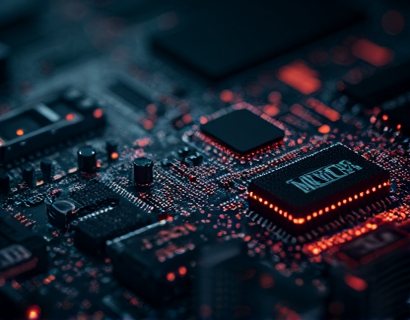Advanced Layer 2 Solutions: Revolutionizing Blockchain Scalability and Efficiency for EVM-Enabled Development
In the rapidly evolving landscape of blockchain technology, scalability and efficiency have emerged as critical challenges for developers, especially those working with Ethereum Virtual Machine (EVM)-enabled platforms. The inherent limitations of Layer 1 blockchains, such as limited transaction throughput and high gas fees, have spurred the development of advanced Layer 2 solutions. These solutions aim to enhance scalability, security, and efficiency, enabling the creation of faster, more secure, and cost-effective decentralized applications (dApps). This article delves into the transformative impact of advanced Layer 2 solutions on EVM-based blockchain development, providing insights for blockchain developers and innovators.
Understanding Layer 2 Solutions
Layer 2 solutions refer to technologies built on top of existing blockchain networks (Layer 1) to improve performance and reduce costs. Unlike Layer 1 upgrades, which involve modifying the core protocol, Layer 2 solutions operate within the existing framework, offloading some of the computational and transactional load. This approach allows for greater flexibility and faster implementation without the need for consensus among all network participants.
For EVM-enabled blockchains, Layer 2 solutions are particularly crucial. The EVM, while powerful, has limitations in terms of scalability and cost efficiency. Transactions on the EVM can be slow and expensive, especially during peak times. Layer 2 solutions address these issues by processing transactions off the main chain, thereby reducing congestion and lowering fees. This not only enhances user experience but also opens up new possibilities for dApp development.
Key Advanced Layer 2 Solutions
Several advanced Layer 2 solutions have gained prominence in the blockchain ecosystem, each offering unique benefits and use cases. Some of the most notable solutions include state channels, sidechains, and rollups.
State Channels
State channels allow multiple parties to conduct a series of transactions off the main blockchain, with the final state being submitted to the blockchain once the channel is closed. This method significantly reduces the number of transactions recorded on the main chain, thereby lowering fees and increasing transaction speed. State channels are particularly useful for applications requiring frequent and small transactions, such as gaming and micropayments.
For EVM-based development, state channels can be implemented using smart contracts that manage the opening, closing, and state transitions of the channel. Developers can leverage existing EVM-compatible platforms that support state channel protocols, ensuring seamless integration with their dApps.
Sidechains
Sidechains are independent blockchains that are linked to the main blockchain, allowing assets to be transferred between the two. This setup enables sidechains to operate with different consensus mechanisms and rules, optimizing for specific use cases. Sidechains can handle a higher volume of transactions and offer faster confirmation times, making them ideal for high-throughput applications.
For EVM-based development, sidechains can be integrated using bridges that ensure interoperability between the main chain and the sidechain. Developers can deploy smart contracts on the sidechain that mirror their EVM-based contracts, providing a scalable and cost-effective solution for their dApps.
Rollups
Rollups are one of the most promising Layer 2 solutions for EVM-enabled blockchains. They come in two main types: Optimistic Rollups and ZK Rollups.
Optimistic Rollups bundle multiple transactions into a single transaction on the main chain, with a fraud proof mechanism to ensure validity. This approach significantly reduces the load on the main chain while maintaining security. Developers can deploy their smart contracts on the main chain, benefiting from faster transaction processing and lower fees.
ZK Rollups, on the other hand, use zero-knowledge proofs to bundle and verify transactions off-chain, submitting a compact proof to the main chain. This method offers even higher scalability and faster finality, making it suitable for applications requiring high transaction volumes and low latency.
Both types of rollups can be integrated with EVM-based development by using wrappers and adapters that translate EVM contracts into the rollup environment. This ensures that developers can continue using their familiar tools and frameworks while enjoying the benefits of Layer 2 scalability.
Enhancing Security and Efficiency
One of the primary concerns with Layer 2 solutions is the potential trade-off between scalability and security. Advanced Layer 2 solutions, however, have been designed to maintain or even enhance the security of EVM-based blockchains.
State channels and rollups, for instance, employ robust cryptographic techniques to ensure the integrity of off-chain transactions. State channels use secure multi-party computation (MPC) to manage channel state transitions, while rollups utilize zero-knowledge proofs to verify the correctness of batched transactions. These mechanisms provide strong guarantees against fraud and ensure that the final state on the main chain is always accurate.
Moreover, advanced Layer 2 solutions often incorporate mechanisms to handle disputes and ensure finality. For example, Optimistic Rollups allow users to submit fraud proofs, while ZK Rollups rely on the infallibility of zero-knowledge proofs. These features provide developers with confidence in the security of their dApps, even as they leverage Layer 2 scalability.
Cost Efficiency and User Adoption
Cost efficiency is another critical aspect of advanced Layer 2 solutions. By reducing the number of transactions on the main chain, these solutions significantly lower gas fees, making blockchain applications more accessible to a broader audience. This cost reduction is particularly beneficial for dApps that require frequent user interactions, such as decentralized finance (DeFi) platforms and gaming applications.
Lower fees not only improve the user experience but also encourage greater adoption of blockchain technology. As more users can afford to interact with dApps, the ecosystem grows, leading to increased network effects and innovation. For developers, this means larger user bases and more opportunities to build and monetize their applications.
Furthermore, the reduced computational load on the main chain allows for more efficient use of resources, enabling developers to deploy and maintain complex dApps at a lower cost. This efficiency is crucial for startups and smaller development teams that may have limited resources but ambitious goals.
Future of Blockchain Innovation
The integration of advanced Layer 2 solutions is poised to drive the future of blockchain innovation. As these technologies mature, we can expect to see even more sophisticated applications and use cases emerge. For EVM-based development, the combination of Layer 2 scalability and EVM's robust smart contract capabilities creates a powerful synergy.
Developers can leverage Layer 2 solutions to build dApps that are not only faster and cheaper but also more resilient and user-friendly. The ability to handle high transaction volumes without compromising security opens up new possibilities in areas such as decentralized gaming, social networks, and supply chain management.
Moreover, the interoperability between different Layer 2 solutions and main chains fosters a more connected and versatile blockchain ecosystem. Developers can design dApps that seamlessly integrate multiple Layer 2 layers, creating hybrid solutions that maximize the benefits of each technology.
Conclusion
Advanced Layer 2 solutions are revolutionizing blockchain scalability and efficiency, particularly for EVM-enabled development. By offloading transaction processing to separate layers, these solutions reduce congestion, lower fees, and enhance security, paving the way for faster and more cost-effective dApp development. As the technology continues to evolve, the potential for innovation in the blockchain space is immense, offering exciting opportunities for developers and users alike.










































